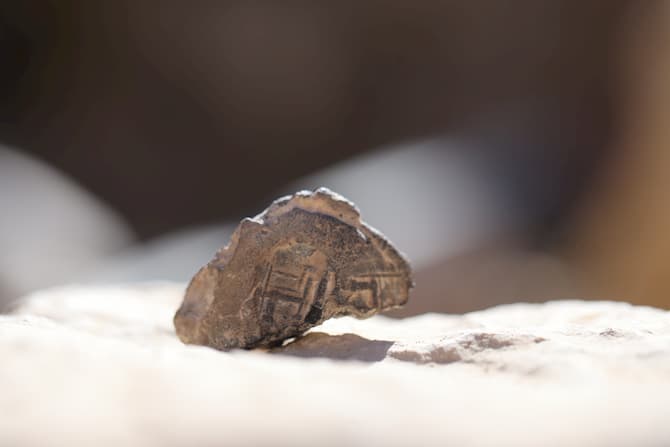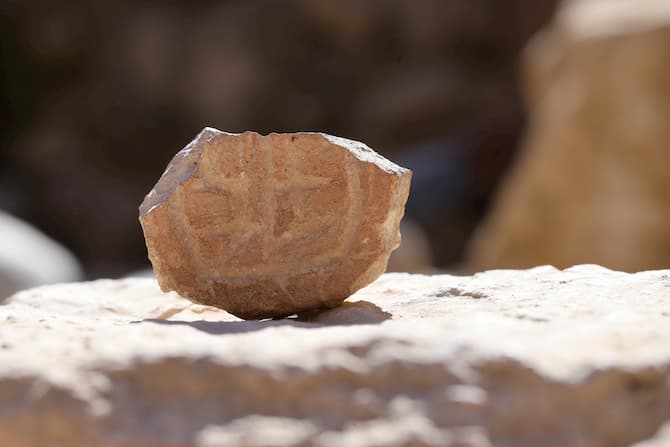How did Jerusalem deal with the massive destruction inflicted on it by the Babylonian army in the 6th century BCE? A double seal impression on a stamp and a pottery seal dating, with high probability, to the Persian period, may provide an answer to this interesting question. The findings were discovered in archaeological excavations by the Antiquities Authority and Tel Aviv University in the Givati Parking Lot in the City of David, in the National Park surrounding the walls of Jerusalem, and they were found in an area that was cleaned and organized in the ruins of a large building that was destroyed during the Babylonian destruction of Jerusalem.
Photography and editing: Eliyahu Yanai, courtesy of the City of David Archives
According to Prof. Yuval Gadot from the Department of Archeology and Ancient Middle Eastern Cultures at Tel Aviv University and Dr. Yiftach Shalev from the Antiquities Authority, “Despite the many excavations that have been conducted in Jerusalem to date, the findings that have been discovered from the Persian period so far are extremely scarce; because of this there is also a lack of information about the character and appearance of the city in the period this. Uncovering these findings in an archaeological context that can be dated with high probability is very rare,” the researchers emphasize.
The seal impressions – the stamps – were small pieces of clay that in ancient times were used to sign documents or containers (for example jars to store agricultural produce collected as a tax), and were designed to keep them closed on the way to their destination. Often, the objects themselves were either not opened or did not survive (especially the letters), but the stamps, which are made of a material similar to ceramic, were actually preserved, leaving evidence of the existence of the administrative systems, and even of the people in charge of them.
According to Prof. Gadot and Dr. Shalev, “The finding of the stamp and the seal in the City of David shows that despite the city’s difficult situation after the destruction, efforts were made to restore the administrative systems to their proper state, and its residents continued to use the buildings that were destroyed there.”
The double seal impression was discovered on a large piece of clay. The piece of clay, about 4.5 cm in size, indicates that it was used to close a large container, perhaps a jug, and was not for a letter. The imprint shows the figure of a man sitting on a large chair with two pillars in front of him. The design of the image indicates that it was made using a Babylonian-type seal. The figure is apparently a king, and the pillars are the symbols representing the gods Nebo and Marduk. According to Dr. Ido Koch of the Department of Archeology and Ancient Near Eastern Cultures at Tel Aviv University, only about 10 items of this style have been found in Israel, including in Ein Gedi and Jerusalem, which seem to have been in use during the Persian period. Another stamp of this style, also of the Persian period, was discovered in the excavations conducted by Dr. Eilat Mazar on the eastern side of the Hill of the City of David.
The seal, made of a large piece of pottery, was locally produced. On the outer side of it, a circular frame has been engraved, divided into two sections with several linear engravings. It is possible that the engravings represent two figures, and it is possible that this is a pseudo-epigraphic seal (bearing drawings intended to resemble letters). A fracture can be seen on the back of the seal, possibly indicating that in the past, a handle that was attached there. The size of the seal, about 8 cm in diameter, indicates that it was used to sign large objects.
There were other finds along with these items, including, for example, a fragment of a bass instrument decorated with a face. According to the researchers, “The discovery of the new findings on the western slope of the Hill of the City of David provides a lot of additional information about the structure of the city during the Return of Zion, a period that up to now we have been familiar with mainly from biblical literature (the books of Ezra and Nehemiah). The paucity of findings from this time period made it difficult to understand the status and scope of the city. The findings from the excavation under the Givati Parking Lot shed light on the renewal of the local administration system, in a location similar to the one where the administration was located even before the destruction of the First Temple, about a hundred years earlier.”






